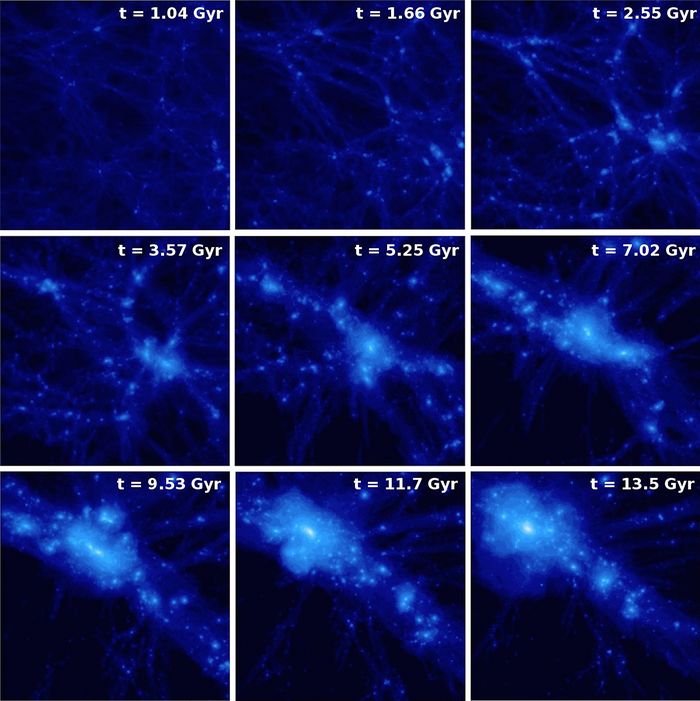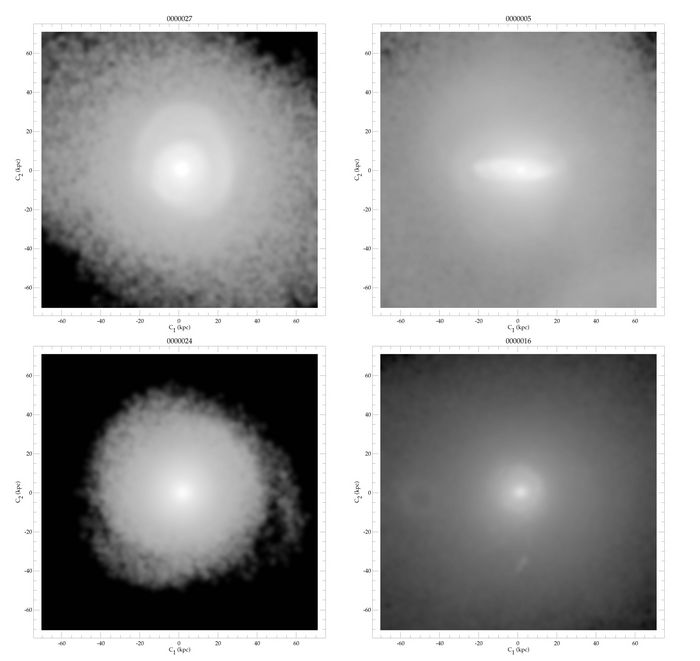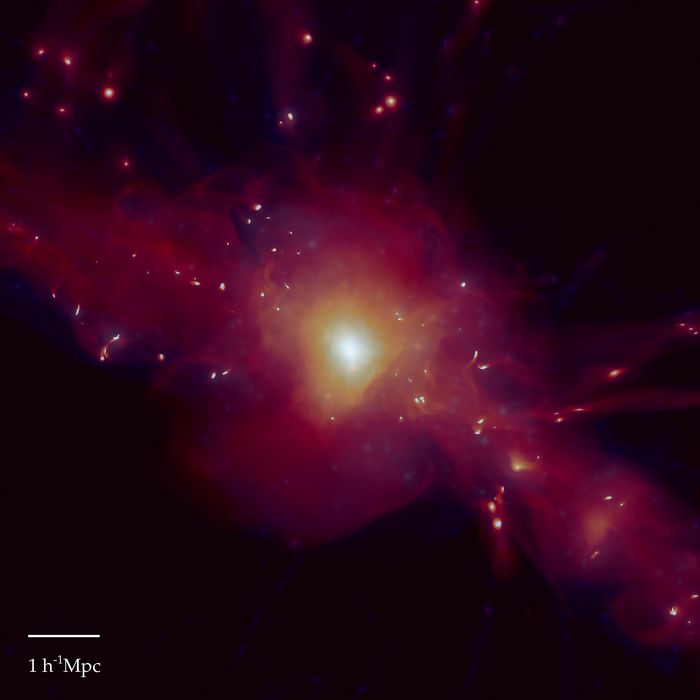ASTROPHYSICS
Light on the Virgo Cluster of Galaxies: Our Closest Cluster-Neighbour
Principal Investigator:
Jenny Sorce
Affiliation:
Leibniz-Institut für Astrophysik Potsdam (Germany) and Centre de Recherche Astrophysique de Lyon (France)
Local Project ID:
pr74je
HPC Platform used:
SuperMUC of LRZ
Date published:
Introduction
Galaxy clusters are large reservoirs of galaxies (agglomerate of stars, planets and dust). As such they are perfect objects of studies to unravel the mysteries of galaxy formation and evolution in dense environments. At a distance of about 50 million light-years away from Earth, the Virgo cluster, a gathering of more than a thousand galaxies, is our closest cluster-neighbour. Its proximity with us permits deep observations. However, assessing the past history of the Virgo cluster from nowadays observations is not trivial. At this stage, cosmological numerical simulations of the cluster come in handy. In such simulations, dark matter (nature of most of the matter in the Universe) and baryons (visible matter) follow physical laws to reproduce our closest cluster-neighbour and its galaxies in a simulated box across cosmic time.
However there exists a large variety of clusters born in different cosmic environments. Thus reproducing our closest cluster-neighbour within its cosmological environment constitutes a numerical challenge. Efficient simulacra of the Virgo cluster can be obtained via simulations that resemble our cosmic neighbourhood down to the cluster scale. Virgo-like clusters form then in the proper environment and permit assessing the most probable formation history of the cluster. To model the galaxy population of the cluster high-resolution simulations are required. Such simulations can be performed only on the largest supercomputers.
Results and Methods
Simulations that resemble our local neighbourhood need to be performed in large boxes to counteract the periodic boundary conditions. Such conditions are essential to fulfill the laws of the conservation of matter. In about 1 billion light-years boxes, reaching a particle mass of 107 times the solar mass is quite challenging especially when including the full hydrodynamical processes followed by the baryons (gas).
A democratized procedure to achieve such resolution in large boxes when the focus is only one object (here the Virgo cluster) is the zoom-in technique. This technique permits increasing the resolution of the simulation only in the region of interest while keeping the rest of the box at low resolution. Thus without any additional computational effort, the effect of the whole box-environment on the cluster is preserved while the time is mostly used to compute at high resolution the history of the cluster and its constituents: the galaxies.
Still, 10 million CPU hours were required to simulate the sole full formation of the cluster from the early Universe until nowadays with full hydrodynamics and with a particle mass of 107 times the solar mass. About 3000 cores were requested. 251 time steps of the simulation were recorded for a total of no less than 21 TB of data. More than 3.6 million files were produced. All these numbers do not include all the preliminary computing time required to test the code, prepare the initial conditions for the simulation and identify the Virgo cluster simulacrum in the selected simulation. More information is available at [1].
Preliminary steps include preparing the observational data to constrain the initial conditions so that the resulting structures in the box, at the end of the simulation run, look like our local environment. This data indeed needs to undergo grouping, bias minimization [2] before being inserted into the whole machinery [3] to produce the initial conditions. 200 initial conditions were prepared and run at a low resolution. They allowed us to identify the unique Virgo cluster look-alike (position, location, mass) in each simulation by identification to our local environment. The observer was assumed to be at the center of the boxes and the latter were oriented like our neighbourhood. With these 200 simulated Virgo clusters, we conducted a statistical study and found for instance that the Virgo cluster had had most probably a quiet merging history within the last 7 gigayears and formed along a preferential direction.
From these 200 simulated Virgo clusters, we selected the cluster whose properties make it the average Virgo cluster. The zoom-in technique implemented in the MUSIC code allowed us to increase the resolution. We ran then the simulation using the RAMSES code with hydrodynamical implementations detailed in [4]. Here again, preliminary tests with the code were necessary to run it properly on the supercomputer.

Figure 1: Formation of the Virgo cluster of galaxies. From left to right, top to bottom: the dark matter particles gather in the simulated box to form the Virgo cluster. From dark blue to white, the matter density increases. The Virgo cluster is the clump of matter visible nowadays, namely 13.5 Gigayears after the big bang. Each slice represents about 30 million light-years.
Copyright: AIP Potsdam, Germany, and CRAL, FranceAfter 10 million CPU hours, the full history of the formation of the Virgo cluster was simulated and recorded. Figure 1 shows this formation. At [1] movies are available. Different time steps were selected to present slices of the distribution of matter in the box, more precisely at the location of the Virgo cluster. The gradient of colors stands for the density gradient. From black to white, the density of particles (matter) increases. From left to right, top to bottom, one can see the formation of the cluster from a homogenized distribution of matter to a huge concentration of matter. Small filaments interconnected by small clumps of matter grow to finally give one major filament (preferential direction) with one enormous clump of matter (more than 1014 times the solar mass): the Virgo cluster of galaxies.
On-going Research / Outlook
At such a high resolution with hydrodynamical features, the simulations contain simulated galaxies of the Virgo cluster look-alike. Figure 2 shows four of them, viewed face-on, in slices of about 300,000 light-years. The next step is then to extract galaxy properties from the simulation like their colors, their metallicity, their star formation, their mass to make deep comparisons with the observed galaxy population of the Virgo cluster. Galaxy formation models can then be validated or/and calibrated.
The step after this one is to run an even higher resolution simulation (to reach 105 times the solar mass) but with solely dark matter to reduce the computational cost. Such a resolution will allow us to simulate the smallest galaxies, called dwarfs, in and around the Virgo cluster of galaxies. To do so, we will use semi-analytical modeling to populate a posteriori the dark matter simulation with galaxies.
Research Team
Jérémy Blaizot, Yohan Dubois, Stefan Gottlöber, Jenny Sorce (PI)
Project Partners
CRAL Lyon, IAP Paris, AIP Potsdam
References and Links
[1] http://jennygsorce.appspot.com/home.html
[2] J.G. Sorce, MNRAS 450 (2015), 2644
[3] J.G. Sorce, S. Gottlöber, G. Yepes, et al., MNRAS 455 (2016), 2078
[4] Y. Dubois, C. Pichon, C. Welker, et al., 444 MNRAS (2014), 1453
Scientific Contact:
Dr. Jenny G. Sorce
Leibniz-Institut für Astrophysik Potsdam (AIP)
An der Sternwarte 16, D-14482 Potsdam (Germany)
E-Mail: jsorce [@] aip.de
Centre de Recherche Astrophysique de Lyon (CRAL-UMR5574),
9 avenue Charles André, 69230 Saint-Genis-Laval
E-Mail: jenny.sorce [@] univ-lyon1.fr
NOTE: This report was first published in the book "High Performance Computing in Science and Engineering – Garching/Munich 2018".
LRZ project ID: pr74je
March 2019

